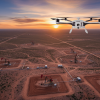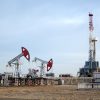The recently announced US nationwide waiver for Beyond Visual Line of Sight (BVLOS) operations means the skies have finally opened for expanded drone operations. The BVLOS waiver is good news for the entire drone industry, and great news for any company that needs to conduct remote visual inspections of industrial sites.
But it’s not enough. While BVLOS approval opens new opportunities for drone-based visual inspections to take off (pardon the pun), it doesn’t solve the two major challenges of visual inspection: efficient, frequent data collection and visual data management. Even if organizations have advanced to using drones for visual inspection, many still struggle with one or both of those challenges because the technologies and processes they use only partially address their needs.
Challenge 1: Collecting high quality, consistent visual data daily
Effective industrial site visual inspection depends on the ability to collect the right data consistently and frequently in order to establish a baseline of all site assets’ health and identify any deviations from that baseline. That requires:
- Data quality: Collecting high-quality RGB and thermal data requires drones that are equipped with advanced cameras and sensors.
- Data consistency: Piloted drone flights are never identical. Different flight paths, differences in the image capture angles, different times of day…. Even slight variations make data analysis challenging.
- Data collection frequency: The frequency of piloted drone flights is limited by the high cost and low availability of drone pilots and the time it takes to manually upload and integrate siloed data.
A drone-in-a-box solution that is ruggedized and can be deployed on-site and operated year round, with advanced payload and management software, solves the data collection challenge by enabling fully remote, high frequency, autonomous visual inspections. Inspections can be scheduled to run as frequently as needed (even multiple times a day) and every flight is identical.
That’s one of the two major challenges solved. The question then becomes: how do you get value from all that high-quality data?
Challenge 2: Leveraging high-quality big data
Turning large amounts of data into insights comes with several challenges:
- Managing large data sets: Frequent, thorough inspections generate massive volumes of visual data. Sifting through it all to find the relevant images or videos for analysis is like finding a needle in a haystack.
- Siloed data: In many cases, data is saved on shared drives or on dedicated softwares not accessible to all stakeholders. A drone pilot may collect great data, however that data in many cases is not getting to all relevant stakeholders, as the process of distributing it is manual. Same goes for insights gleaned from this data.
- Analysis: Analysis, by and large, is being done using the data collected in the most recent drone flight. It is not being compared with historical data, which means you don’t have an up-to-date, comprehensive understanding of defects and issues on your site.
Many available market solutions do a great job handling specific steps in the drone inspection and monitoring workflow. But only a very few provide a comprehensive end-to-end solution that automates both data collection and data management. For instance, many drone solutions focus only on data collection and rely on third-party service providers to handle data processing and analytics. This creates a disconnect and lack of standardization that make it difficult for companies to fully leverage the potential of autonomous drone inspection and achieve real value.
A single end-to-end solution for the entire data collection and management workflow is a must to fully automate visual inspections and leverage remote operations to enhance site reliability, safety and sustainability.
Industrial leaders are seeing the benefits of an end-to-end solution
Leading companies are already using end-to-end autonomous drone solutions to meet a variety of needs. In 2019, Delek US kicked off a plan to use autonomous drones with AI-based analytics for refinery surveillance, reconnaissance, and monitoring. Realizing that an end-to-end solution would be critical to achieving their “refinery of the future” goals, they looked for a solution with the right hardware and software to collect the data they needed and ensure that it would be organized, analyzed quickly, and delivered to the right decision makers.
Delek implemented Percepto’s Autonomous Inspection & Monitoring (AIM) software for automated visual data management from upload to insight together with Percepto Air’s drone-in-a-box (DIB) equipped with an integrated OGI camera to detect emissions in real time and reduce product loss. The team is already seeing results on the ground and plans to significantly expand the implementation of Percepto solutions in the near future.
Delek isn’t alone. Koch Fertilizer integrated an end-to-end inspection solution into their workflows at their Enid, Oklahoma plant. For the fertilizer giant, having automated data collection and visual data management is critical for their organization to meet its productivity and ESG goals. The organization was particularly interested in enhancing employee safety, by sending in automated robots to perform risky inspections.
In a recent storm, for example, the solution enabled Koch Fertilizer to get their operations up and running quickly and safely, sending in autonomous drones to inspect critical infrastructure with Percepto AIM quickly analyzing their plant health status. For Koch, being able to do all that without putting their employees in harm’s way is critical, enabling them to ensure plant reliability and safety.
Autonomous drone inspection can also play a significant role in emergency situations like wildfires, where an on-site drone-in-a-box solution is the only feasible way to conduct monitoring. When the massive Big Hollow Fire shut down human access to a large area of Washington state in 2020, Verizon needed a way to make sure that fire, heat, water, or smoke damage wasn’t interrupting critical rescue and firefighting communications. That required powerful software that could enable remote operations and analyze Verizon’s infrastructure quickly to alert the team about any failures.
With Percepto’s comprehensive solution, Verizon was able to respond quickly, dispatching autonomous drones to inspect and monitor network infrastructure from 1600 miles away. Percepto’s Autonomous Inspection and Monitoring (AIM) delivered AI-powered insights that allowed Verizon engineers to confirm the integrity and operability of its infrastructure without putting any personnel in harm’s way.
With a single end-to-end inspection and monitoring solution, these organizations and others like them can conduct more frequent, higher-quality inspections and detect and act on problems before they lead to downtime. Employee safety improves since inspections of hazardous areas can be conducted remotely. Stakeholders benefit from quality, data-based, actionable insights that deliver maximum value to their enterprise without pouring endless resources into visual data management.
A complete solution is more than the sum of its parts
As those companies have learned, automating one component of the solution isn’t enough. A great drone-in-a-box solution creates big data challenges when it isn’t paired with advanced data management. A great data management and analysis platform can’t deliver the same value without frequent, high-quality, consistent data collected from an advanced drone-in-a-box.Bottom line – companies have much to gain from choosing a complete solution that automates everything. From data collection to data processing and analysis.





